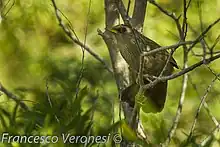Taiwan hwamei
The Taiwan hwamei (Garrulax taewanus) is a passerine bird in the family Leiothrichidae. The species was first described by Robert Swinhoe in 1859. It is endemic to the island of Taiwan. It was formerly regarded as a subspecies of the Chinese hwamei (Garrulax canorus) but has since been split as a separate species. It is estimated to have diverged from the Chinese hwamei about 1.5 million years ago.[3]
| Taiwan hwamei | |
|---|---|
 | |
| Scientific classification | |
| Domain: | Eukaryota |
| Kingdom: | Animalia |
| Phylum: | Chordata |
| Clade: | Dinosauria |
| Class: | Aves |
| Order: | Passeriformes |
| Family: | Leiothrichidae |
| Genus: | Garrulax |
| Species: | G. taewanus |
| Binomial name | |
| Garrulax taewanus R. Swinhoe, 1859 | |
| Synonyms | |
| |
It is about 24 centimetres long. It is mainly grey brown with heavy streaks on the crown, nape and back and fine streaks on much of the underparts. It lacks the white eye-markings of the Chinese hwamei which is also more rufous in colour and less heavily streaked. The whistling song is long, melodious and varied.
It inhabits secondary woodland in the foothills and lower mountains up to 1,200 metres above sea level. It forages alone, in pairs or in small groups, searching amongst the understorey for insects and seeds.
It has a declining population of 1,000–10,000 individuals and is classified as a near threatened species by BirdLife International. Habitat loss may affect its numbers but the main threat is hybridization with introduced populations of the Chinese hwamei.
Hybridization
On the island of Taiwan, the Taiwan hwamei is known to interbreed with its sister species, the Chinese hwamei (Garrulax canorus).[4] The Chinese hwamei is imported from China to Taiwan for the melodic and complex song of the males. Due to flaws in sexing of birds, females are accidentally imported and, because they cannot sing, are released into the wild where they hybridize with the native Taiwan hwamei. As a result of the release of this invasive species and its interaction with the native Taiwan hwamei, Li et al. suggest that the amount of introgression (found to be 20% in their study) is compromising the distinctiveness of the Taiwan species.[5]
References
- BirdLife International (2016). "Garrulax taewanus". IUCN Red List of Threatened Species. 2016: e.T22734473A95086939. doi:10.2305/IUCN.UK.2016-3.RLTS.T22734473A95086939.en. Retrieved 11 November 2021.
- "Appendices | CITES". cites.org. Retrieved 2022-01-14.
- Shou-Hsien Li, Jing-Wen Li, Lian-Xian Han, Cheng-Te Yao, Haitao Shi, Fu-Min Lei, Chungwei Yen (2006) "Species delimitation in the Hwamei Garrulax canorus", Ibis 148 (4): 698–706. doi:10.1111/j.1474-919X.2006.00571.x
- Li, S; Li, Jing-Wen; Han, Lian-Xian (July 2006). "Species delimitation in the Hwamei Garrulax canorus". Ibis. 148 (4): 698–706. doi:10.1111/j.1474-919X.2006.00571.x.
- Li, Shou-Hsien; Yeung, Carol K.-L.; Han, Lianxian; Le, Manh Hung; Wang, Chi-xan; Ding, Ping; Yao, Cheng-te (January 2010). "Genetic introgression between an introduced babbler, the Chinese hwamei Leucodioptron c. canorum , and the endemic Taiwan hwamei L. taewanus: a multiple marker systems analysis". Journal of Avian Biology. 41 (1): 64–73. doi:10.1111/j.1600-048X.2009.04719.x.
- BirdLife International (2008) Species factsheet: Garrulax taewanus. Retrieved 22/05/08.
- MacKinnon, John & Phillipps, Karen (2000) A Field Guide to the Birds of China, Oxford University Press, Oxford.
- Birding in Taiwan - Hwamei Retrieved 22/05/08.
- Handbook of Birds of the World (2019) Taiwan Hwamei. Retrieved 19/11/19
